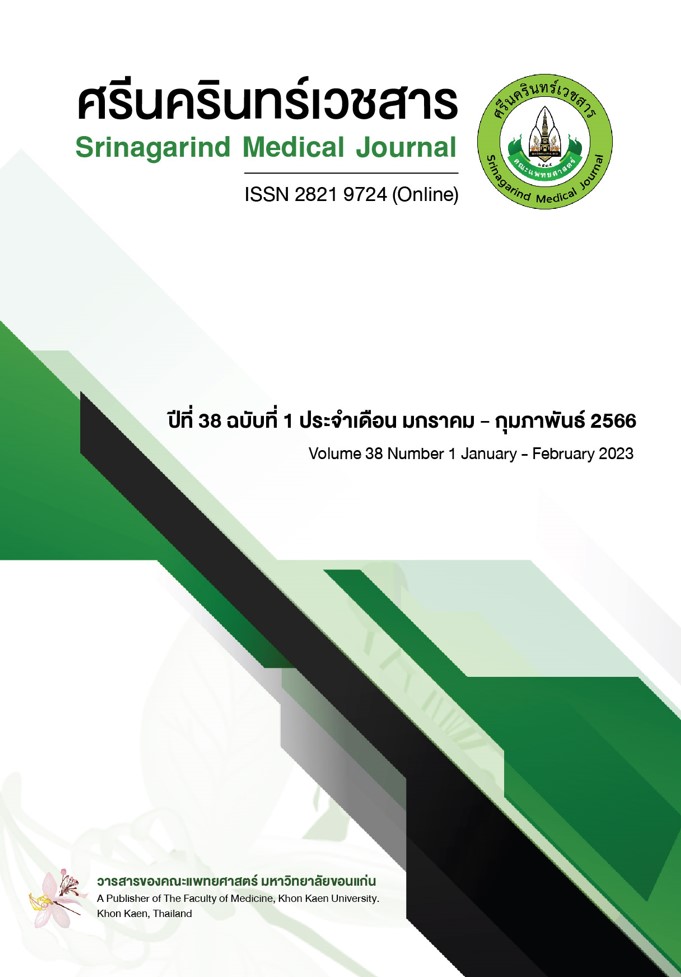ประสิทธิผลของการพัฒนาระบบบริการแบบไร้รอยต่อในการบริบาลฟื้นฟูสภาพผู้ป่วยระยะกลางเครือข่ายจังหวัดร้อยเอ็ด
Abstract
Effectiveness of Seamless Service System Development in the Care of Rehabilitation for Intermediate Care in Roi Et Province Network
Wiraporn Narongrat1, Maliwan Ankhanit2
1 Department of Rehabilitation Medicine, Roi Et Hospital
2 Department of Research and Nursing Development
หลักการและวัตถุประสงค์: การฟื้นฟูสภาพช่วยเพิ่มคุณภาพชีวิตผู้ป่วยระยะกลาง การศึกษานี้เพื่อศึกษาสถานการณ์ พัฒนารูปแบบบริการและประสิทธิผลของการพัฒนาระบบบริการแบบไร้รอยต่อ
วิธีการศึกษา: เป็นการศึกษาเชิงปฏิบัติการมี 3 ระยะ 1) ระยะศึกษาสถานการณ์ 2) ระยะพัฒนารูปแบบ และ 3) ระยะประเมินผลลัพธ์ ศึกษาที่โรงพยาบาลร้อยเอ็ดและโรงพยาบาลชุมชน 20 แห่ง มี 2 กลุ่มตัวอย่าง ได้แก่ 1) สหวิชาชีพ และ 2) ผู้ป่วยระยะกลาง 789 ราย เก็บข้อมูล ตุลาคม 2563 ถึง ธันวาคม 2564 แบบผสมผสานวิธี ศึกษาเอกสารหลักฐานเชิงประจักษ์ การสนทนากลุ่ม การบันทึก การสังเกตพฤติกรรมและตอบแบบสอบถาม วิเคราะห์ข้อมูลเชิงคุณภาพโดยการวิเคราะห์เนื้อหาและข้อมูลเชิงปริมาณโดยการแจกแจง ความถี่ ร้อยละ ค่าเฉลี่ย ส่วนเบี่ยงเบนมาตรฐาน และ independent t-test
ผลการศึกษา: พบว่า 1) การฟื้นฟูผู้ป่วยระยะกลางไม่ชัดเจน เจ้าหน้าที่ขาดข้อมูลผู้ป่วย ผู้ป่วยและญาติไม่เห็นความสำคัญ และขาดทุนทรัพย์ 2) ระบบบริการแบบไร้รอยต่อมีองค์ประกอบ คือ กำหนดปัญหา ระบบริการมีแนวทางปฏิบัติและส่งต่อด้วยโปรแกรม NEMOCARE ติดตามผลลัพธ์ และ 3) ประสิทธิผลของการพัฒนาฯพบว่าบุคลากรพึงพอใจระดับมาก (=4.70, SD=.78) ผู้ป่วยระยะกลางเพิ่มขึ้น (=12.98, S.D.=7.88, p<0.001) ผู้ป่วยพึงพอใจระดับมากร้อยละ 88.46 (=25.78, S.D.=1.50, p<0.001) และเพิ่มคุณภาพผลลัพธ์
สรุป: ประสิทธิผลของการพัฒนาฯ เกิดความชัดเจน เพิ่มคุณภาพบริการ เพิ่มคุณภาพชีวิตและพึงพอใจต่อระบบบริการ
Background and Objectives: Rehabilitation could improves quality of life for intermediate care patients. This research was to study the situation, improve the service model and the effectiveness of the development of a seamless service system.
Methods: This was an Action research consisting of 3 phases: 1) the situation study phase, 2) the model development phase, and 3) the model outcome evaluation phase. Two sample groups were studied at Roi Et hospital and 20 community hospitals: 1) multidisciplinary teams and 2) 789 intermediate care patients. Data were collected from October 2020 to December 2021 using the mixed methods; evidence-based documentation, group discussions, recordings, behavioral observations and questionnaires. Qualitative data were analyzed by content analysis and quantitative data by distribution, frequency, percentage, mean, standard deviation and independent t-test statistics.
Results: It was found that 1) the situation of intermediate care was unclear. The staff lacked patient information. Patients and their families do not see the importance of rehabilitation and have financial problems. 2) The seamless service system consists of the following elements: problem determination, organize a service system to have practical guidelines, referral system with NEMOCARE program and, monitoring outcome. And 3) the effectiveness of the development was found that 1) the staff were satisfied at a high level (Mean=4.70, SD=.78). 2) There is an increase in the number of intermediate care patients. (=12.98, S.D.=7.88, p<0.001) 3) 88.46% of patients were satisfied with the quality of service at a high level (=25.78, S.D.=1.50, p<0.001) and enhance the quality of clinical outcomes.
Conclusion: The effectiveness of the development to create clear system, to increase service quality, to increase quality of life and to be satisfied with the service system.
Downloads
Published
Issue
Section
License

This work is licensed under a Creative Commons Attribution-NonCommercial-NoDerivatives 4.0 International License.


